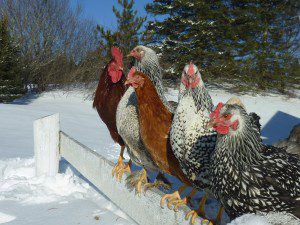Bird Flu in Backyard Flocks
What Poultry and Game Bird Owners Should Know

Recently, highly pathogenic avian influenza (Bird Flu) was found in wild birds in Washington, Oregon, Utah, California and most recently in Minnesota. This virus can also infect poultry commonly found in backyard flocks. The strains were identified as H5N8 and H5N2 and typically do not cause disease in most wild birds but will cause severe disease in gallinaceous birds (domestic poultry and game birds). The strains are described as highly pathogenic because of rapid spread and high mortality in domesticated poultry.
Clinical Signs of Avian Influenza: Owners of poultry and other game birds should be aware of the clinical signs of avian influenza, which are highly variable and include: lack of energy, decreased egg production, nasal discharge, coughing, swelling and discoloration of the head, combs and/or wattles, diarrhea, and neurologic signs such as stumbling.
Minimizing Risk of Infection: The key factor in minimizing risk of infection to domesticated birds is to limit contact with wild birds and migratory wildfowl. Also important is to maintain a clean environment and to avoid sharing tools or supplies with other poultry owners. All purchased birds should originate from a reputable seller.
What to do with suspect cases: Questions about or observation of the above clinical signs or any event of high mortality in a flock should be reported to:
- Your local veterinarian
- The Department of Agriculture, Trade and Consumer Protection (608)-224-4876
https://datcp.wi.gov/Animals/Animal_Diseases/index.aspx
https://datcp.wi.gov/Animals/Animal_Diseases/Avian_Influenza/index.aspx
https://datcp.wi.gov/uploads/Animals/pdf/PoultryVets04.02.14.pdf
How to test birds for viral infection: One way to control the disease is by testing birds for the presence of the virus prior to movement, sale or to comply with a surveillance requirement such as those specified in the National Poultry Improvement Program (NPIP).
The Wisconsin Veterinary Diagnostic Laboratory is fully accredited and equipped with the expertise to test for avian influenza, as well as many other pathogens. The test that is performed is a real-time polymerase chain reaction (PCR). This assay can amplify small amounts of viral nucleic acid so it is more readily detected by an instrument. Moreover, the assay is very rapid and can be completed in the same day the sample is received.
Please order supplies for this test by going to our website FORMS page and choosing the choosing the AI Swab Kit for PCR Order Form. The kit contains 6 tubes of broth and swabs with a polyester tip and plastic applicator. An experienced veterinary technician or veterinarian can provide training on how to take the sample.
Click HERE for an instructional video demonstrating proper sampling technique.
For backyard flocks and game birds, each is sampled by swabbing the choanal slit. Samples from up to 5 birds can be pooled, using a different swab for each bird. After sampling a bird, immerse the swab tip in the tube of broth, gently agitate, squeeze the cotton tip against the side of the tube, then discard the swab. Repeat for each bird sampled. Tightly close the tube and ship with an ice pack. Affix the label identifying this package as an Avian Diagnostic sample. Ship for overnight delivery using our UPS shipping program. https://www.wvdl.wisc.edu/index.php/shipping-information
On the supply order form, please indicate the reason for testing (sick birds, surveillance as required by NPIP, or pending sale).
If you have birds with clinical signs consistent with avian influenza, you will be contacted by a WVDL veterinarian to discuss testing.
Please contact the WVDL at anytime with questions. wvdl.wisc.edu
608-262-5432